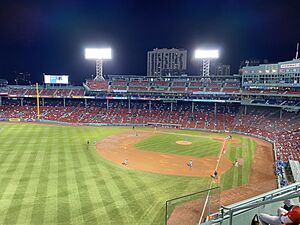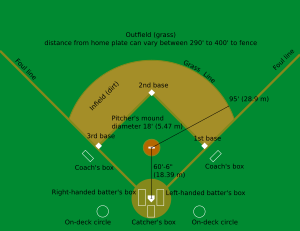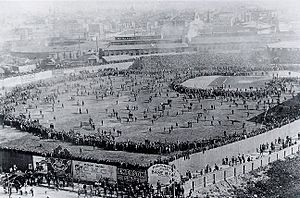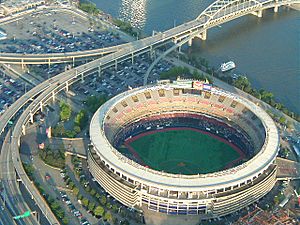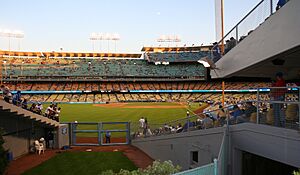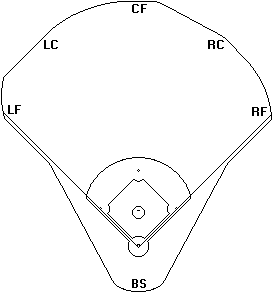Ballpark facts for kids
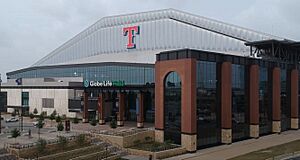
A ballpark, also called a baseball park, is a special place where baseball games are played. Think of it as a big field with seats for fans. The playing area is split into two main parts: the infield and the outfield. The infield has strict measurements for where the bases are, but the outfield can be different sizes and shapes in each ballpark. Bigger ballparks are sometimes called baseball stadiums.
Contents
- What Makes a Ballpark Special?
- How Ballparks Got Their Names
- Where Ballparks Are Built
- Different Kinds of Ballparks
- Wooden Ballparks: The Early Days
- Jewel Box Ballparks: The Classics
- Multi-Purpose Stadiums: One Size Fits All?
- Indoor Ballparks: Beating the Weather
- Modern Ballparks: Baseball-Focused Design
- Retractable-Roof Ballparks: Open or Closed
- Retro-Classic Ballparks: A Nod to the Past
- Retro-Modern Ballparks: Old Meets New
- Contemporary Ballparks: Looking to the Future
- Temporary and Converted Ballparks
- Current Major League Stadiums
- Images for kids
- See Also
What Makes a Ballpark Special?
The Baseball Field: A Diamond Shape
The main playing area is often called a diamond. The infield is a perfect diamond shape made of dirt and grass. It holds the three bases, home plate, and the pitcher's mound. Usually, there's grass between the bases and home plate, with a dirt mound in the middle for the pitcher. Some fields use artificial turf, and a few, like Koshien Stadium in Japan, have an all-dirt infield.
Two white lines stretch out from home plate, going past first and third base. These are the foul lines. If a batter hits the ball outside these lines, it's a "foul" ball, and the play stops. If it lands on or between the lines, it's a "fair" ball. At the end of these lines are foul poles. If a ball hits a foul pole in the air, it's a home run!
Near home plate, there are two batter's boxes where players stand to hit. Behind home plate is the catcher's box, where the catcher and umpire stand. Coaches' boxes are next to first and third base. Coaches stand here to give signals to players running the bases.
Away from the field, you'll find the dugouts. This is where players and coaches sit when they're not playing. They're called "dugouts" because they are often built below the field level. This helps fans in the seats see the game better.
Beyond the infield is the large, grassy outfield. It's usually about twice as deep as the infield. Fences surround the playing field. Outfield fences can be different heights. Sometimes, a fence is made taller if it's very close to home plate.
Many professional ballparks have a "warning track" around the field. It's a strip of dirt or rubber about 10 feet wide. This track warns players that they are getting close to the fence, so they don't crash into it.
Behind the outfield fence, there's a special area called the batter's eye. This area has no seats and is usually a dark color. It helps the batter see the white baseball clearly when it's pitched.
Most major league ballparks face north or east. This is so the setting sun doesn't shine directly into the batter's eyes during games.
Where Fans Sit: Grandstands and Bleachers
Today, in Major League Baseball, a large seating area called a grandstand wraps around the infield. It often has many levels. How far these seats go down the field lines changes from park to park. In smaller leagues, the grandstands are much smaller.
Beyond the outfield fence, the seating is usually different. This area might have cheaper bleacher seats or smaller grandstands. In local parks, you might just see a few rows of metal bleachers.
Ballpark Differences: Not All Fields Are the Same
Unlike sports like football or basketball, which have fixed-size fields, baseball fields can vary a lot in their outfield shape and size. Only the infield has strict measurements.
Baseball leagues often set a minimum distance from home plate to the outfield fences. Better players hit the ball farther, so bigger fields prevent too many home runs. Since 1958, new major league fields must be at least 325 feet down the lines and 400 feet to center field. However, many newer parks have received special permission to have different sizes.
Older ballparks, like Fenway Park, were allowed to keep their original sizes. For example, Fenway Park has a famous 37-foot-high wall in left field called the Green Monster. This tall wall helps stop easy home runs in that shorter part of the field. Some ballparks even have fences that are shaped unevenly, with curves or sharp angles, to make the game more interesting. These unique shapes often came from how the land was available when the park was built.
How Ballparks Got Their Names
Baseball started in open fields or public parks. One famous early spot was Elysian Fields in New Jersey, where people played organized games in the 1840s. That's why early baseball places were often called "Field" or "Park."
When professional baseball began, fields added seats and fences to charge people to watch. Then, names like "Grounds" became popular, such as the Union Grounds in 1862. The last major league "Grounds" was the Polo Grounds in New York City, which was taken down in 1964.
The word "stadium" has been used for sports places since ancient times. As baseball grew, bigger venues were built. Yankee Stadium, built in 1923, was one of the most famous to use "Stadium" in its name. After that, most new major league venues used "Stadium."
Later, for indoor fields, the word "Dome" was added, like the Houston Astrodome. In recent years, some new parks have gone back to using "Park" in their names, even for domed stadiums.
Where Ballparks Are Built
The location and design of ballparks depend on many things, like how many people they need to hold and how fans get there. Early ballparks were often far from city centers. Going to a game was a big event, and fans used public transportation.
As professional baseball grew, games became more common. It became important for fans to get to games easily. Many ballparks were built closer to city centers or in neighborhoods where fans lived. Classic ballparks often had little space for cars because most fans took public transport. This is still true for places like Fenway Park in Boston and Wrigley Field in Chicago.
Later, as more fans owned cars and moved to the suburbs, parking became a big deal. Some ballparks added parking garages, or new parks were built in the suburbs with huge parking lots. These stadiums often looked like an "island" in a "sea" of parking.
Today, many new ballparks try to offer both: a city location with good public transportation and plenty of parking.
Different Kinds of Ballparks
Wooden Ballparks: The Early Days
The first professional baseball fields were large wooden ballparks. They had seats on wooden platforms and sometimes iron poles for support. The outfield had tall walls covered in ads. Wood was cheap, but it had a big problem: it dried out and caught fire easily. Many parks burned down completely.
Because of the fires and baseball's growing popularity, builders started using stronger, fire-resistant materials like steel and concrete. These new parks often lasted for many decades and are now called "jewel boxes." Today, no professional wooden ballparks are left.
Jewel Box Ballparks: The Classics
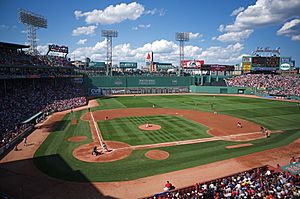
The first ballparks built with reinforced concrete, brick, and steel are known as jewel box ballparks or classic parks. The Baker Bowl in Philadelphia (1895) was one of the first to use steel and brick. Shibe Park (1909), also in Philadelphia, was the first to use reinforced concrete.
These parks often had two levels of seating. Steel pillars supported the upper decks, which sometimes blocked the view for some lower seats. But these upper decks could be built very close to the field. Yankee Stadium was built with three levels to hold huge crowds, setting a new standard.
Many jewel box parks were built in city blocks, so their outfield fences often had unusual shapes and tall walls. This was to prevent too many easy home runs. Famous examples include the 40-foot wall at League Park in Cleveland and the Green Monster at Fenway Park.
These parks sometimes hosted other sports like football. The seats were usually angled best for baseball. Today, only Fenway Park and Wrigley Field are still used by Major League Baseball teams.
Multi-Purpose Stadiums: One Size Fits All?
From the 1960s to the early 1990s, many multi-purpose ballparks were built. People sometimes called them "concrete donuts" because they were often round or square and made of bare concrete. The idea was to build one stadium that could host baseball, football, and soccer, saving money.
These stadiums often had seating that faced the center of the field, not home plate. This meant some seats were very far from the action. The outfield dimensions were usually symmetrical. While they were cost-effective, these stadiums often weren't great for any one sport.
A big change in these parks was the cantilevered upper deck. This design removed the support columns that blocked views in older parks. However, it also meant the upper decks had to be farther from the field, and roofs were smaller, leaving fans more exposed to the weather.
The Rogers Centre in Toronto, opened in 1989, was a multi-purpose stadium with a retractable roof and even a hotel! It was a big step forward. However, most purely open-air multi-purpose parks are no longer used for baseball. The Oakland Coliseum was the last one, but the Athletics moved out in 2024.
Indoor Ballparks: Beating the Weather
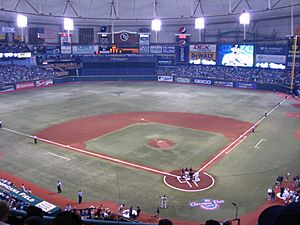
Indoor parks have a fixed roof, often a hard concrete dome. They were built to escape bad weather, like the heat and humidity in Houston (the Astrodome) or the rain in Seattle (the Kingdome).
Because there's little natural light, these parks usually have artificial turf instead of real grass. Artificial turf makes the ball bounce faster and higher, which changes the game. The roofs were often dull white or gray, making it hard for batters to see fly balls.
The Hubert H. Humphrey Metrodome in Minneapolis had a roof made of inflatable fiberglass, held up by air pressure. It collapsed three times in its first three years due to heavy snow!
Today, Tropicana Field is the only indoor-only park built just for baseball that still hosts a Major League Baseball team. It is expected to be replaced soon. Newer indoor stadiums can now grow real grass, but the first ones couldn't.
Modern Ballparks: Baseball-Focused Design
While many teams built multi-purpose stadiums, some chose to build parks just for baseball. These modern ballparks kept some new features, like cantilevered upper decks (no blocked views) and colorful seats. They often had plain concrete outsides and symmetrical outfields.
Many modern parks, like Dodger Stadium and Kauffman Stadium, have aged well. Instead of building new ones, teams have updated them with new features. Milwaukee County Stadium was an early example, known for its round outfield fence and colorful seats.
Dodger Stadium, opened in 1962, is a great example of a modern ballpark that has been updated but still keeps its original design. Rogers Centre and Tropicana Field can also be seen as modern ballparks, even with their special roofs.
The last modern ballpark built in North America was New Comiskey Park (now Rate Field) in 1991. It has since been updated to look more like a retro-classic park.
Retractable-Roof Ballparks: Open or Closed
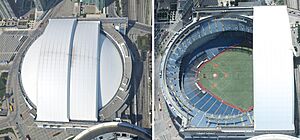
Retractable-roof parks offer the best of both worlds: they can be closed to protect from bad weather or opened when the weather is nice. To support the roof, most are enclosed on all sides.
A key feature of these parks is a large area where the roof slides or folds when it's open. The Rogers Centre in Toronto was the first fully working retractable-roof park. Its roof folds back over a hotel in center field.
Retractable-roof parks come in many styles, from simple designs like Rogers Centre to those with classic or modern touches. The style depends on when they were built. For example, Chase Field has a retractable roof and a swimming pool, which were new ideas for ballparks.
Retro-Classic Ballparks: A Nod to the Past
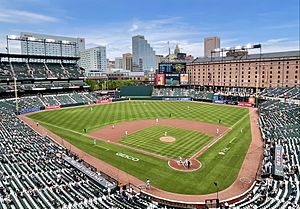
In 1992, Oriole Park at Camden Yards opened in Baltimore. It looked like the old "jewel box" parks with its red brick and forest green colors, but it had modern features and comforts. This started a trend for retro-classic ballparks.
Since Camden Yards, many major league teams have built new ballparks with unique designs. These parks are mainly for baseball, but they can also host other events. Rate Field, originally a modern park, was updated with retro-classic features like different roof shapes and a dark green color.
The newest retro-classic ballparks opened in New York City in 2009: Citi Field (inspired by Ebbets Field) and Yankee Stadium (like the old "House that Ruth Built"). However, teams are now moving towards retro-modern or contemporary designs.
Retro-Modern Ballparks: Old Meets New

Some ballparks combine the classic feel of retro parks with modern looks. These are called retro-modern ballparks. Progressive Field, built in 1994, was one of the first. It had the unique fences and smaller upper decks of a retro park, but its outside didn't look like the old brick jewel boxes.
Many parks today follow this style. Their outsides often use white or gray steel instead of brick. They might also have modern elements like glass walls or retractable roofs.
Angel Stadium is a great example. It started as a modern park, became a multi-purpose stadium, and then was renovated to a retro-modern ballpark. It now has green steel and sandstone-colored concrete, with much of its outfield seating removed to look more like its original design.
Chase Field, opened in 1998, was a retro-modern park with a retractable roof and even a swimming pool! This showed how new features could be added to the retro style. Later retro-modern parks, like Nationals Park and Target Field, used more glass and unique designs, pushing the style even further.
Contemporary Ballparks: Looking to the Future
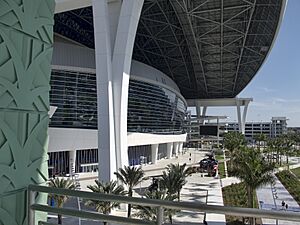
After two decades of retro styles, a new design appeared in 2012 with the opening of LoanDepot Park in Miami. This new style is called contemporary. Its goal is to show off the current culture of the city where the stadium is built, moving away from looking like old ballparks.
USA Today noted that LoanDepot Park might mark the end of the "Camden Yards era" of retro design. This park has a unique, Miami-themed design with sculptural glass, curved shapes, and bright colors.
Es Con Field Hokkaido in Japan, opened in 2023, is another example of this contemporary style. The new ballpark for the Las Vegas Athletics is also being designed to fit the modern feel of the Las Vegas Strip.
Temporary and Converted Ballparks

Sometimes, teams need a place to play while a new stadium is being built. These are called temporary ballparks. For example, when the Dodgers moved to California, they played in the Los Angeles Memorial Coliseum while Dodger Stadium was under construction.
Converted ballparks are existing minor league or college fields that are made bigger for a major league team. They were originally built for baseball, just not for the major leagues. Memorial Stadium in Baltimore and Metropolitan Stadium in Minnesota were examples of converted ballparks.
Recently, temporary ballparks have been used again. Sahlen Field hosted the Toronto Blue Jays in 2020 and 2021 due to travel rules. Sutter Health Park is the temporary home for the Athletics from 2025 to 2027. Also, George M. Steinbrenner Field will be the temporary home for the Tampa Bay Rays in 2025 after Tropicana Field was damaged by a hurricane.
These types of ballparks are defined by how they are used, not by their design. So, a temporary or converted ballpark could also be a jewel box, modern, or multi-purpose style.
Current Major League Stadiums
This table shows the distances from home plate to different parts of the outfield wall for current Major League Baseball stadiums.
- LF and RF are distances along the foul lines.
- LC and RC are for the "power alleys" (where many home runs are hit).
- CF is for center field.
- BS is the distance behind home plate to the backstop.
In 1958, MLB said new parks should be at least 325 feet down the lines and 400 feet to center. Older parks didn't have to follow this rule. However, many new parks have been allowed to have different sizes since 1991.
| Stadium | Team | City | Capacity | LF | LC | CF | RC | RF | BS |
|---|---|---|---|---|---|---|---|---|---|
| American Family Field | Milwaukee Brewers | Milwaukee | 41,900 | 344 ft | 370 ft | 400 ft | 374 ft | 337 ft | 54 ft |
| Angel Stadium | Los Angeles Angels | Anaheim, California | 45,957 | 330 ft | 382 ft | 400 ft | 365 ft | 330 ft | 59 ft |
| Busch Stadium | St. Louis Cardinals | St. Louis | 43,975 | 335 ft | 375 ft | 400 ft | 375 ft | 335 ft | 55 ft |
| Chase Field | Arizona Diamondbacks | Phoenix | 48,519 | 330 ft | 376 ft | 407 ft | 376 ft | 335 ft | 58 ft |
| Citi Field | New York Mets | Queens, New York | 41,922 | 335 ft | 379 ft | 408 ft | 383 ft | 330 ft | 45 ft |
| Citizens Bank Park | Philadelphia Phillies | Philadelphia | 43,651 | 329 ft | 355 ft | 401 ft | 357 ft | 330 ft | 60 ft |
| Comerica Park | Detroit Tigers | Detroit | 41,574 | 345 ft | 370 ft | 420 ft | 388 ft | 330 ft | 62 ft |
| Coors Field | Colorado Rockies | Denver | 50,398 | 347 ft | 390 ft | 415 ft | 382 ft | 350 ft | 54 ft |
| Daikin Park | Houston Astros | Houston | 41,574 | 315 ft | 404 ft | 409 ft | 408 ft | 326 ft | 56 ft |
| Dodger Stadium | Los Angeles Dodgers | Los Angeles | 56,000 | 330 ft | 368 ft | 400 ft† | 368 ft | 330 ft | 53 ft |
| Fenway Park | Boston Red Sox | Boston | 37,673* | 310 ft | 389 ft 9 in†† | 420 ft | 380 ft | 302 ft | 60 ft |
| Globe Life Field | Texas Rangers | Arlington, Texas | 40,300 | 329 ft | 372 ft | 407 ft | 374 ft | 326 ft | 42 ft |
| Great American Ball Park | Cincinnati Reds | Cincinnati | 42,319 | 328 ft | 365 ft | 404 ft | 365 ft | 325 ft | 52 ft |
| Rate Field | Chicago White Sox | Chicago | 40,615 | 335 ft | 375 ft | 400 ft | 375 ft | 330 ft | 60 ft |
| Kauffman Stadium | Kansas City Royals | Kansas City, Missouri | 37,903 | 330 ft | 387 ft | 410 ft | 387 ft | 330 ft | 50 ft |
| loanDepot park | Miami Marlins | Miami | 36,742 | 344 ft | 386 ft | 407 ft | 392 ft | 335 ft | 47 ft |
| Nationals Park | Washington Nationals | Washington, D.C. | 41,888 | 336 ft | 377 ft | 402 ft | 370 ft | 335 ft | 53 ft 2 in |
| Sutter Health Park | Athletics | West Sacramento, California | 10,624 | 330 ft | 403 ft | 325 ft | 58 ft | ||
| Oracle Park | San Francisco Giants | San Francisco | 41,915 | 339 ft | 399 ft | 391 ft | 415 ft | 309 ft | 48 ft |
| Oriole Park at Camden Yards | Baltimore Orioles | Baltimore | 45,971 | 333 ft | 364 ft | 410 ft | 373 ft | 318 ft | 58 ft |
| Petco Park | San Diego Padres | San Diego | 39,860 | 334 ft | 378 ft | 396 ft | 387 ft | 322 ft | 45 ft |
| PNC Park | Pittsburgh Pirates | Pittsburgh | 38,362 | 325 ft | 389 ft | 399 ft | 364 ft | 320 ft | 55 ft |
| Progressive Field | Cleveland Guardians | Cleveland | 34,820 | 325 ft | 370 ft | 410 ft††† | 375 ft | 325 ft | 60 ft |
| Rogers Centre | Toronto Blue Jays | Toronto | 41,500 | 328 ft | 375 ft | 400 ft | 375 ft | 328 ft | 60 ft |
| T-Mobile Park | Seattle Mariners | Seattle | 47,574 | 331 ft | 375 ft | 405 ft | 365 ft | 326 ft | 62 ft |
| Target Field | Minnesota Twins | Minneapolis | 38,649 | 339 ft | 377 ft | 404 ft | 367 ft | 328 ft | 46 ft |
| George M. Steinbrenner Field | Tampa Bay Rays | Tampa, Florida | 11,026 | 318 ft | 399 ft | 408 ft | 385 ft | 314 ft | |
| Truist Park | Atlanta Braves | Cumberland, Georgia | 41,149 | 335 ft | 385 ft | 400 ft | 375 ft | 325 ft | TBA |
| Wrigley Field | Chicago Cubs | Chicago | 42,495 | 355 ft | 368 ft | 400 ft | 368 ft | 353 ft | 60 ft |
| Yankee Stadium | New York Yankees | The Bronx | 46,537 | 318 ft | 399 ft | 408 ft | 385 ft | 314 ft | 52 ft 4 in |
* Fenway Park holds 37,227 people during day games.
** Tropicana Field can expand to hold 42,735 people.
†The actual distance to center field is 400 feet; the 395-foot markings are to the left and right of dead center.
††At Fenway Park, deep center is 379 feet and straightaway center is 389.75 feet.
†††At Progressive Field, the distance to deep center field is 410 feet and straightaway center is 400 feet.
Images for kids
See Also
- List of baseball parks by capacity
- List of Major League Baseball stadiums
- List of U.S. baseball stadiums by capacity
- Scoreboard


